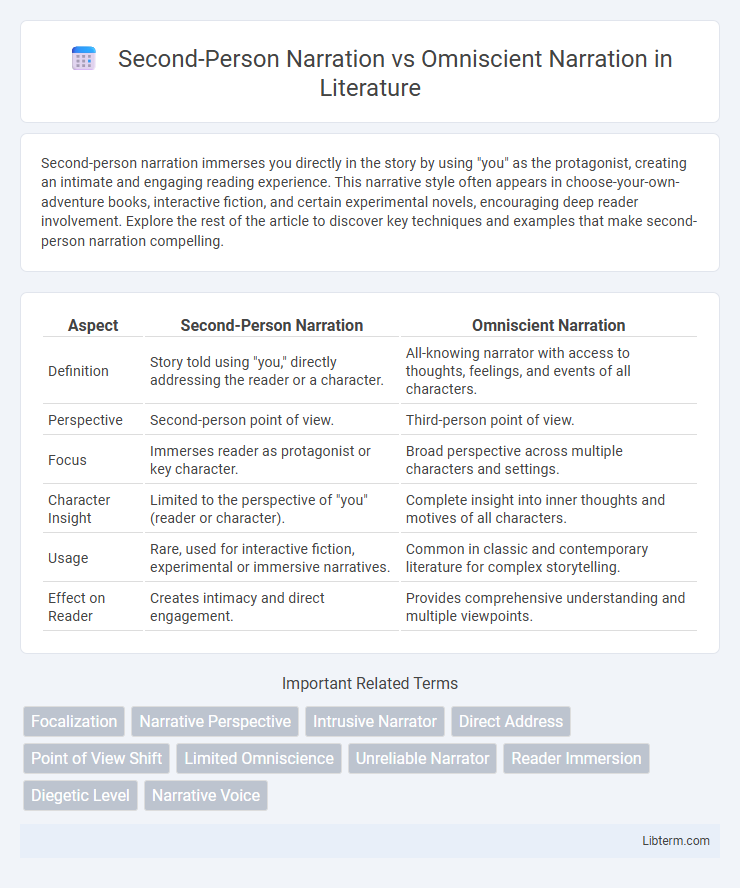Second-person narration immerses you directly in the story by using "you" as the protagonist, creating an intimate and engaging reading experience. This narrative style often appears in choose-your-own-adventure books, interactive fiction, and certain experimental novels, encouraging deep reader involvement. Explore the rest of the article to discover key techniques and examples that make second-person narration compelling.
Table of Comparison
| Aspect | Second-Person Narration | Omniscient Narration |
|---|---|---|
| Definition | Story told using "you," directly addressing the reader or a character. | All-knowing narrator with access to thoughts, feelings, and events of all characters. |
| Perspective | Second-person point of view. | Third-person point of view. |
| Focus | Immerses reader as protagonist or key character. | Broad perspective across multiple characters and settings. |
| Character Insight | Limited to the perspective of "you" (reader or character). | Complete insight into inner thoughts and motives of all characters. |
| Usage | Rare, used for interactive fiction, experimental or immersive narratives. | Common in classic and contemporary literature for complex storytelling. |
| Effect on Reader | Creates intimacy and direct engagement. | Provides comprehensive understanding and multiple viewpoints. |
Introduction to Narrative Perspectives
Second-person narration directly addresses the reader using "you," creating an immersive and personalized experience often used in interactive fiction and instructional writing. Omniscient narration offers a comprehensive viewpoint with an all-knowing narrator who reveals characters' thoughts, feelings, and unseen events, providing deeper insight into the story's world. Understanding these distinct narrative perspectives enhances the writer's ability to control reader engagement and convey thematic depth.
Defining Second-Person Narration
Second-person narration directly addresses the reader using pronouns like "you," creating an immersive and interactive experience that places the audience within the story. This narrative style contrasts with omniscient narration, where an all-knowing narrator provides comprehensive insight into multiple characters' thoughts and events. Second-person narration is effective in genres such as interactive fiction, self-help books, and Choose Your Own Adventure stories, as it fosters personal engagement and immediacy.
Understanding Omniscient Narration
Omniscient narration provides a comprehensive perspective by revealing the thoughts, feelings, and motivations of multiple characters within a story. This narrative style allows for a deeper understanding of complex plotlines and character interactions through an all-knowing narrator voice. Writers leveraging omniscient narration can craft intricate narratives that explore various points of view, enhancing emotional depth and thematic richness.
Reader Engagement: Second-Person vs Omniscient
Second-person narration directly immerses the reader by addressing them as "you," creating a personalized and immediate connection that heightens engagement through involvement in the story. Omniscient narration offers a comprehensive view of characters' thoughts and events, enabling readers to grasp multiple perspectives and deeper context, which fosters intellectual engagement and a broader understanding of the narrative. While second-person narration evokes a strong emotional response by positioning readers within the story, omniscient narration captivates through expansive insight and narrative complexity.
Narrative Voice and Tone Comparison
Second-person narration directly engages the reader as the protagonist, creating an intimate and immersive narrative voice that often adopts a commanding or introspective tone. Omniscient narration offers a detached, all-knowing voice that provides insight into multiple characters' thoughts and feelings, resulting in a more balanced and authoritative tone. The contrast between these narrative voices shapes the reader's emotional involvement and perspective, with second-person emphasizing immediacy and omniscient prioritizing comprehensive understanding.
Impact on Storytelling Structure
Second-person narration immerses readers by addressing them directly, creating an intimate and immediate connection that often results in a non-linear or fragmented storytelling structure to maintain engagement. Omniscient narration provides a comprehensive overview of all characters and events, allowing for a more traditional, structured narrative with multiple perspectives and layers of information. The choice between these narrations significantly shapes narrative pacing, depth of character insight, and the overall immersive experience of the story.
Advantages of Second-Person Narration
Second-person narration directly engages the reader by placing them at the center of the story, creating an immersive and interactive experience. This perspective enhances emotional connection and immediacy, making the narrative feel personal and compelling. Writers utilize second-person narration to evoke introspection and uniquely challenge readers' perspectives, distinguishing it from the broader scope of omniscient narration.
Strengths of Omniscient Narration
Omniscient narration offers the unique advantage of providing comprehensive insight into multiple characters' thoughts, emotions, and motivations, enriching the narrative depth and complexity. This narrative style allows seamless shifts in perspective and time, enabling a broader understanding of the story's context and themes. The narrator's all-knowing presence enhances the ability to foreshadow events and reveal hidden connections, creating a more immersive and layered reading experience.
Challenges and Limitations of Each Style
Second-person narration faces challenges in maintaining reader engagement due to its directive tone, often limiting the depth of character development and making sustained immersion difficult. Omniscient narration provides comprehensive insight into multiple characters' thoughts and emotions but can overwhelm readers with excessive information, potentially diluting narrative tension. Both styles require careful balance to avoid distancing the audience--second-person risks alienation through overuse of direct address, while omniscient narration may sacrifice intimacy for breadth.
Choosing the Right Narrative Perspective
Choosing the right narrative perspective is crucial for shaping reader engagement and story depth, with second-person narration immersing the reader directly by using "you" to create a personal, interactive experience. Omniscient narration offers a comprehensive viewpoint, revealing characters' thoughts and multiple plotlines, which enhances thematic complexity and broader understanding. Writers must evaluate their story's emotional goals and scope to determine whether the intimate immediacy of second-person or the expansive insight of omniscient narration best suits their narrative needs.
Second-Person Narration Infographic

 libterm.com
libterm.com